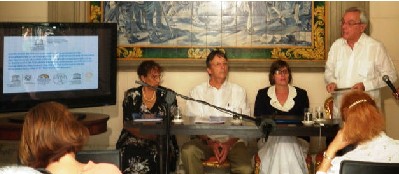
©
UNESCO Havana. Dr. Eusebio Leal speaking. He is accompanied (from left to
right) by Berarda Salabarría, Herman van Hooff, and Gladys Collazo.
On the 40th anniversary of the UNESCO Convention
Concerning the Protection of the World Cultural and Natural Heritage, the 30th
anniversary of the declaration of Old Havana and its fortress system as World
Heritage Sites, and the 20th anniversary of the UNESCO Programme "Memory
of the World", a press conference was held on Tuesday, November 30. It was
convened by the UNESCO Regional Office for Culture in Latin America and the
Caribbean at its headquarters in coordination with senior representatives of
the Office of the City Historian (OHC), the National Cultural Heritage Council
(CNPC), and the Cuban Committee "Memory of the World" under the
umbrella of the Cuban National Commission for UNESCO.
In his presentation, Herman van Hooff, director
of the host organization, provided an overview of the World Heritage
Convention, highlighting that the major aim of this standard-setting
instrument, which dates back to 1972, is to cover, in one single document, the
concepts of cultural preservation and natural conservation. He also made
special emphasis on the long-term commitment assumed by States and local
authorities and communities to preserving World Heritage Sites.
While referring to the "Memory of the
World" Programme, the official underlined that this UNESCO initiative has
contributed to the preservation of the documentary heritage for two decades and
has facilitated universal access to it. He recalled that hundreds of works from
all over the planet have so far been inscribed on its International List,
including 36 collections from 26 countries of Latin America and the Caribbean.
These topics were complemented with the
presentations made by Gladys Collazo, CNPC president; and Berarda Salabarría,
Cuban Committee chairperson. They referred to the new World Heritage Sites in
Cuba and to the two works inscribed on the "Memory of World"
International List (documents written by national hero and intellectual José
Martí and original negatives of the Latin American Newsreel of the Cuban Film
Institute / Noticiero ICAIC Latinoamericano). They also dealt with other
matters of common concern related to various ways of heritage protection and
preservation.
In his presentation, Havana Historian Eusebio
Leal highlighted the importance of having included Old Havana and its fortress
system on the World Heritage List. He recalled that this had been the first
historical centre in the island Caribbean to be recognized as such. He added
that he joined the celebrations without forgetting the damage caused by
hurricane Sandy last Thursday in the eastern provinces of Santiago de Cuba and
Holguín. The other speakers also made mention of this lamentable event.
Finally, Leal indicated that the Office of the
City Historian and the National Cultural Heritage Council are willing to
support recovery works in the historical centre of Santiago de Cuba, one of the
most seriously affected areas, and to send restorers and other highly qualified
personnel to help repair museum pieces damaged by the natural disaster.
"Working hard is the best way to mark these anniversaries," he
stressed.
